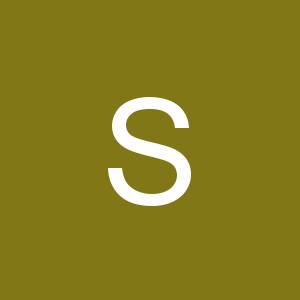
GPSR: Greedy Perimeter Stateless Routing for Wireless Networks. B. Karp, H. T. Kung Borrowed some slides from Richard Yang’s. Motivation. A sensor net consists of hundreds or thousands of nodes Scalability is the issue

sandra_john + Follow
Download PresentationAn Image/Link below is provided (as is) to download presentation Download Policy: Content on the Website is provided to you AS IS for your information and personal use and may not be sold / licensed / shared on other websites without getting consent from its author. Content is provided to you AS IS for your information and personal use only. Download presentation by click this link. While downloading, if for some reason you are not able to download a presentation, the publisher may have deleted the file from their server. During download, if you can't get a presentation, the file might be deleted by the publisher.

Cooperative Diversity Techniques for Wireless Networks. Arun ‘Nayagam Wireless Information Networking Group (WING) Department of Electrical and Computer Engineering University of Florida. Introduction. Antenna arrays commonly used to achieve receive diversity
1.31k views • 32 slides

Chapter 6 Wireless and Mobile Networks. Computer Networking: A Top Down Approach 4 th edition. Jim Kurose, Keith Ross Addison-Wesley, July 2007. . Background: # wireless (mobile) phone subscribers now exceeds # wired phone subscribers!
1.71k views • 114 slides
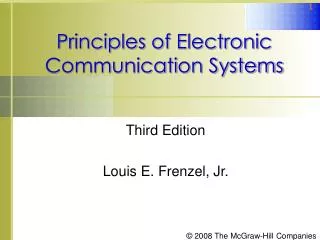
Principles of Electronic Communication Systems. Third Edition Louis E. Frenzel, Jr. Chapter 21. Wireless Technologies. Topics Covered in Chapter 21. 21-1: Wireless LAN 21-2: PANs and Bluetooth 21-3: ZigBee and Mesh Wireless Networks 21-4: WiMAX and Metropolitan-Area Networks
2.62k views • 65 slides

Introduction Issues Design Goals Classifications TCP Over Ad Hoc Wireless Networks Other Transport Layer Protocols. Security in Ad Hoc Wireless Networks Network Security Requirements Issues and challenges in security Network security attacks Key Management Secure Routing.
4.26k views • 85 slides
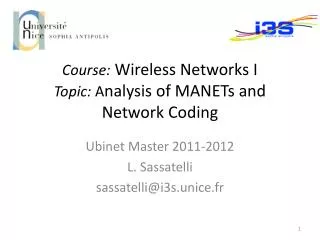
Course: Wireless Networks I Topic : A nalysis of MANETs and Network Coding. Ubinet Master 2011-2012 L. Sassatelli sassatelli@i3s.unice.fr. Outline. Delay-Throughput trade-offs: Static ad hoc networks under the physical and protocols models Mobile ad hoc networks
1.54k views • 118 slides
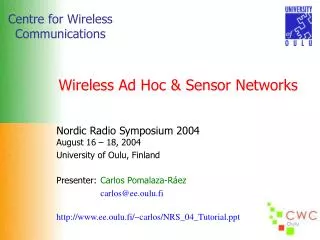
Wireless Ad Hoc & Sensor Networks. Nordic Radio Symposium 2004 August 16 – 18, 2004 University of Oulu, Finland Presenter: Carlos Pomalaza-Ráez carlos@ee.oulu.fi http://www.ee.oulu.fi/~carlos/NRS_04_Tutorial.ppt. Outline. Mobile Ad Hoc Networks (MANETs) Main features
1.6k views • 117 slides

CCNA Discovery 2: Chapter 6. Routing. Contents. 6.1: Routing Protocols 6.1.1 : Routing 6.1.2 : Routing Protocols 6.1.3 : RIP, EIGRP, OSPF 6.1.4: Routing Metrics 6.1.5: RIP configuration 6.2: Exterior Routing Protocols 6.2.1 : Autonomous Systems 6.2.2: Routing Across the Internet
1.24k views • 71 slides
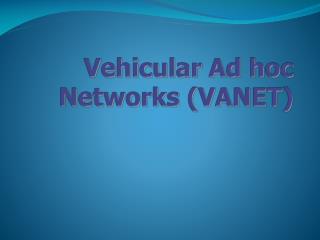
Vehicular Ad hoc Networks (VANET). Wireless Networks. 2008/10/1. A taxonomy of wireless networks. 4. 2008/10/1. Examples. Ad Hoc Networks. Non-infrastructure Fixed and Mobile Nodes Special Classes of Ad Hoc Networks Vehicular Ad Hoc Networks Wireless Mesh Networks
3.33k views • 78 slides

Network-Aware Distributed Algorithms for Wireless Networks Nitin Vaidya Electrical and Computer Engineering University of Illinois at Urbana-Champaign. Multi-Channel Wireless Networks: Theory to Practice. Nitin Vaidya Electrical and Computer Engineering
1.08k views • 95 slides

Chapter 7 Packet-Switching Networks. Chapter 7 Packet-Switching Networks. Network Services and Internal Network Operation Packet Network Topology Datagrams and Virtual Circuits Routing in Packet Networks Shortest Path Routing ATM Networks Traffic Management.
1.8k views • 151 slides
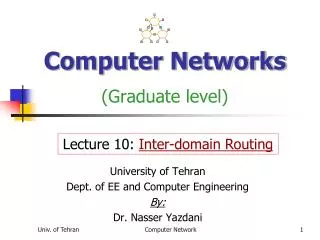
Computer Networks (Graduate level). Lecture 10: Inter-domain Routing. University of Tehran Dept. of EE and Computer Engineering By: Dr. Nasser Yazdani. Inter-Domain Routing. Border Gateway Protocol (BGP) Assigned reading [LAB00] Delayed Internet Routing Convergence Sources
1.29k views • 111 slides
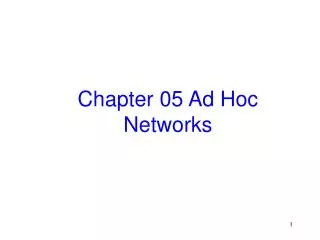
Chapter 05 Ad Hoc Networks. Outline. Introduction Unicast routing TCP on Mobile Ad Hoc Networks Selected security issues. 5.1 Mobile Ad Hoc Networks (MANET) Introduction and Generalities. 5.1.1 Mobile Ad Hoc Networks. Formed by wireless hosts which may be mobile
2.23k views • 187 slides

Leader Election and Mutual Exclusion Algorithms for Wireless Ad Hoc Networks. CPSC 661 Distributed Algorithms Abhishek Gaurav Alok Madhukar. Part 1: Leader Election Algorithms for Wireless Ad Hoc Networks. What is a mobile ad hoc network? Use of Leader election in mobile systems
1.29k views • 103 slides
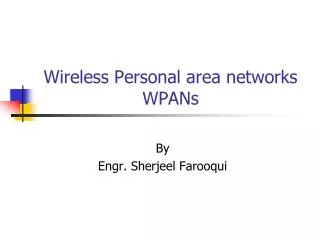
Wireless Personal area networks WPANs. By Engr. Sherjeel Farooqui. WAN 2G, 3G 2km/link national areas. MAN 802.16 2-6km. PAN 802.15.x 10m. LAN 802.11 100m. Overview of wireless networks. IEEE 802.15 - General. Wireless Personal Area Networks (WPANs) Short Range Low Power
1.42k views • 80 slides
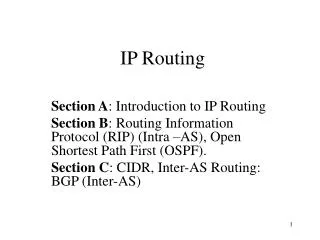
IP Routing. Section A : Introduction to IP Routing Section B : Routing Information Protocol (RIP) (Intra –AS), Open Shortest Path First (OSPF). Section C : CIDR, Inter-AS Routing: BGP (Inter-AS). Section A IP Routing. Routing: Process of choosing a path over which to send packets.
2.09k views • 111 slides
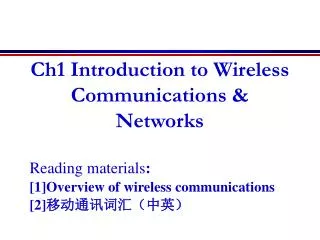
Ch1 Introduction to Wireless Communications & Networks. Reading materials : [1]Overview of wireless communications [2] 移动通讯词汇(中英). Outline. Part 1 Introduction to Wireless Communication & Networks Part 2 Applications of Wireless Networks.
1.63k views • 91 slides
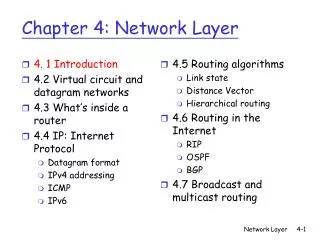
4. 1 Introduction 4.2 Virtual circuit and datagram networks 4.3 What’s inside a router 4.4 IP: Internet Protocol Datagram format IPv4 addressing ICMP IPv6. 4.5 Routing algorithms Link state Distance Vector Hierarchical routing 4.6 Routing in the Internet RIP OSPF BGP
1.69k views • 142 slides

WIRELESS SENSOR NETWORKS. `. T opics. Introduction What are WSNs? An example: ESB WSN applications Energy conservation Ad-hoc routing Basic principles Overview of routing protocols Data-centric protocols Rumor Routing Geogra phical protocols. Localization and Positioning
1.54k views • 105 slides

Emerging Concepts and Technologies towards 5G Wireless Networks. Halim Yanıkömeroğlu Carleton University Ottawa, Canada. Outline. Part I: 16:00 – 16:45 1. The new wireless 2. Generations of cellular technologies 3. What we know and what we don’t know
1.55k views • 123 slides

Chapter 8: Troubleshooting Converged Networks. CCNP TSHOOT: Maintaining and Troubleshooting IP Networks. Chapter 8 Objectives. Troubleshoot Wireless issues in a converged network supporting wireless devices and clients.
1.48k views • 124 slides

UNIT-7. Mobile Ad hoc Networks. Contents. Syllabus from chapter 15, 17 in handbook of wireless networks and mobile computing. By Ivan Stojmenovic. MANET overview Properties of MANET MANET applications Routing and various routing algorithms Unicast routing protocols for MANET
1.22k views • 94 slides